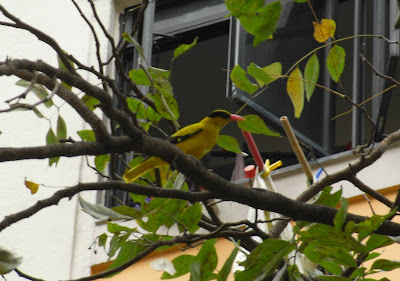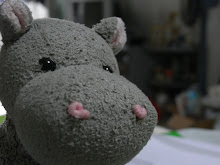 The whole time we were there, the bird flew in and out of this recess, gathering dried leaves to build its nest, presumably.
The whole time we were there, the bird flew in and out of this recess, gathering dried leaves to build its nest, presumably. Just found out that this is an Olive-backed Sunbird (Cinnyris jugularis)*. For clearer pictures, do take a look at the Mangoverde World Bird Guide Species Page: Olive-backed Sunbird - http://www.mangoverde.com/birdsound/spec/spec166-94.html. Check out http://rmbr.nus.edu.sg/nis/bulletin2008/2008nis207-210.pdf for interesting information about the display of the male Olive-backed Sunbird and its pectoral tufts. [Edit]
Just found out that this is an Olive-backed Sunbird (Cinnyris jugularis)*. For clearer pictures, do take a look at the Mangoverde World Bird Guide Species Page: Olive-backed Sunbird - http://www.mangoverde.com/birdsound/spec/spec166-94.html. Check out http://rmbr.nus.edu.sg/nis/bulletin2008/2008nis207-210.pdf for interesting information about the display of the male Olive-backed Sunbird and its pectoral tufts. [Edit] Front view of a female Olive-backed Sunbird, though somewhat blurry. Males of this species are more brightly-coloured than the females, with metallic blue feathers covering the front of their heads and extending to their breasts. Have a look at a picture of a male here. [Edit]
Front view of a female Olive-backed Sunbird, though somewhat blurry. Males of this species are more brightly-coloured than the females, with metallic blue feathers covering the front of their heads and extending to their breasts. Have a look at a picture of a male here. [Edit] I always pass by this canal on my way to school, except this time I was on foot. Was not surprised to see egrets (it seems to be their migratory season now and they're fairly common in Singapore during this time). The bird on the right appears to be a Little Egret (Egretta garzetta). I based the ID on the fact that it has a black beak and slight stature. The Chinese Egret (Egretta eulophotes), a globally-threatened species, also has a blackish beak but it is larger, and is much rarer in Singapore during the migratory season.
I always pass by this canal on my way to school, except this time I was on foot. Was not surprised to see egrets (it seems to be their migratory season now and they're fairly common in Singapore during this time). The bird on the right appears to be a Little Egret (Egretta garzetta). I based the ID on the fact that it has a black beak and slight stature. The Chinese Egret (Egretta eulophotes), a globally-threatened species, also has a blackish beak but it is larger, and is much rarer in Singapore during the migratory season. Pretty flowers by the roadside. Likely that this is Ixora sp., as suggested by Ze Lin.
Pretty flowers by the roadside. Likely that this is Ixora sp., as suggested by Ze Lin.Yup, it's an Ixora as confirmed by LK*. More precisely, it's an Ixora cultivar (cultivar refers to a variety of a plant that has been created or selected intentionally and maintained through cultivation as stated at Dictionary.com) which has been given the name of Ixora 'Super Pink'. The name says it all. [Edit]
 The unopened flower buds of Ixora 'Super Pink'*. [Edit] Can see that it has black specks of dirt on its leaves from all the dust and exhaust from passing vehicles.
The unopened flower buds of Ixora 'Super Pink'*. [Edit] Can see that it has black specks of dirt on its leaves from all the dust and exhaust from passing vehicles.  Heads up!
Heads up! This is probably a Plantain Squirrel (Callosciurus notatus), a common resident of Singapore.
This is probably a Plantain Squirrel (Callosciurus notatus), a common resident of Singapore. What my family commonly refers to as the yellow bird is actually the Black-naped Oriole (Oriolus chinensis). Many of us probably hear its cry frequently but do not often see it. Glad I walked home that day and decided to look up. This oriole kind of reminds me of a pirate (Zorro, even) because of its black mask.
What my family commonly refers to as the yellow bird is actually the Black-naped Oriole (Oriolus chinensis). Many of us probably hear its cry frequently but do not often see it. Glad I walked home that day and decided to look up. This oriole kind of reminds me of a pirate (Zorro, even) because of its black mask. This is the Yellow Saraca (Saraca cauliflora aka S. thaipingensis)*. This tree looked as if it was decorated with bouquets of orange-gold from the way its flowers were in bloom. Pretty sight :)
This is the Yellow Saraca (Saraca cauliflora aka S. thaipingensis)*. This tree looked as if it was decorated with bouquets of orange-gold from the way its flowers were in bloom. Pretty sight :) Found an interesting article from the Bird Ecology Study Group on the Saraca and Sunbirds.
Read it at http://besgroup.talfrynature.com/2008/01/30/saraca-and-sunbirds/.
Got more excited upon reading the last sentence -"The tree attracts many species of birds that visit for the flower nectar and fruits.". Wow! The tree is within walking distance from my home..*starts thinking of bird-stalking* [Edit]
Read it at http://besgroup.talfrynature.com/2008/01/30/saraca-and-sunbirds/.
Got more excited upon reading the last sentence -"The tree attracts many species of birds that visit for the flower nectar and fruits.". Wow! The tree is within walking distance from my home..*starts thinking of bird-stalking* [Edit]
 And just before reaching home, I couldn't resist talking one last photo of this Chiku tree, which is otherwise known as the Sapodilla (Manilkara zapota).
And just before reaching home, I couldn't resist talking one last photo of this Chiku tree, which is otherwise known as the Sapodilla (Manilkara zapota).Acknowledgements:
For this post, much of the info was obtained from Private Lives: An Exposé of Singapore's Mangrove (editors: Peter K. L. Ng, Wang Luan Keng and Kelvin K. P. Lim).
*LK, thanks for pointing out the IDs!
Thoughts:
Ever since construction for a park opposite my block began, the neighbourhood has been filled with more cries of different birds, most notably that of the Asian Koel (Eudynamys scolopacea). This morning, upon the urging of my mother who saw a bird with a large wingspan, I quickly turned to look out the window and was wow-ed by the sight. The bird made one turn and then glided past. It mostly had medium brown plumage from what I could see (only saw its underside). The underside of its wings had a white 'row' of feathers near the top whilst the rest of it was brown with speckles. I'd really like to know what bird it was. Two birds come to mind: the Asian Koel and the sparrowhawk. But it could be neither too. Hmm...



No comments:
Post a Comment